Deck 9: The Formation and Structure of Stars
Question
Question
Question
Question
Question
Question
Question
Question
Question
Question
Question
Question
Question
Question
Question
Question
Question
Question
Question
Question
Question
Question
Question
Question
Question
Question
Question
Question
Question
Question
Question
Question
Question
Question
Question
Question
Question
Question
Question
Question
Question
Question
Question
Question
Question
Question
Question
Question
Question
Question
Question
Question
Question
Question
Question
Question
Question
Question
Question
Question
Question
Question
Question
Question
Question
Question
Question
Question
Question
Question
Question
Question
Question
Question
Question
Question
Question
Question
Question
Question

Unlock Deck
Sign up to unlock the cards in this deck!
Unlock Deck
Unlock Deck
1/136
Play
Full screen (f)
Deck 9: The Formation and Structure of Stars
1
_________ are small luminous nebulae excited by nearby young stars.
A)T Tauri stars
B)Herbig-Haro objects
C)O associations
D)Bok Globule
E)Giant molecular clouds
A)T Tauri stars
B)Herbig-Haro objects
C)O associations
D)Bok Globule
E)Giant molecular clouds
Herbig-Haro objects
2
________ is the thermonuclear fusion of hydrogen to form helium operating in the cores of massive stars on the main sequence.
A)The CNO cycle
B)The proton-proton chain
C)Hydrostatic equilibrium
D)The neutrino process
E)None of the above
A)The CNO cycle
B)The proton-proton chain
C)Hydrostatic equilibrium
D)The neutrino process
E)None of the above
The CNO cycle
3
The visual pink glow of the Great Nebula in Orion
A)is a Herbig-Haro object.
B)is a reflection nebula of dust.
C)is an emission nebula of thin gas.
D)contains only young low mass stars.
E)is believed to be about 5 billion years old.
A)is a Herbig-Haro object.
B)is a reflection nebula of dust.
C)is an emission nebula of thin gas.
D)contains only young low mass stars.
E)is believed to be about 5 billion years old.
is an emission nebula of thin gas.
4
Which of the following is NOT evidence of the existence of an interstellar medium
A)extinction of light from distant stars
B)very narrow calcium absorption lines in the spectra of O and B stars
C)reddening of more distant stars
D)dark cloud silhouetted against background stars
E)molecular absorption lines in the spectra of cool stars
A)extinction of light from distant stars
B)very narrow calcium absorption lines in the spectra of O and B stars
C)reddening of more distant stars
D)dark cloud silhouetted against background stars
E)molecular absorption lines in the spectra of cool stars

Unlock Deck
Unlock for access to all 136 flashcards in this deck.
Unlock Deck
k this deck
5
The lower edge of the main-sequence band is known as ________ and represents the location in the H-R diagram at which stars begin their lives as main-sequence stars.
A)the Coulomb barrier
B)hydrostatic equilibrium
C)the birth line
D)the zero-age main sequence
E)the evolutionary track
A)the Coulomb barrier
B)hydrostatic equilibrium
C)the birth line
D)the zero-age main sequence
E)the evolutionary track

Unlock Deck
Unlock for access to all 136 flashcards in this deck.
Unlock Deck
k this deck
6
What causes the outward gas pressure that balances the inward pull of gravity in a main-sequence star
A)the rapid outward flow of gas
B)the rapid inward flow of the gas
C)the high temperature of the gas
D)the high density of the gas
E)the high temperature and the high density of the gas
A)the rapid outward flow of gas
B)the rapid inward flow of the gas
C)the high temperature of the gas
D)the high density of the gas
E)the high temperature and the high density of the gas

Unlock Deck
Unlock for access to all 136 flashcards in this deck.
Unlock Deck
k this deck
7
________ are star-like objects that contain less than 0.08 solar masses and will never raise their core temperatures high enough that the proton-proton chain can begin. Other minor fusion reactions do occur in these objects. They fall in a gap between the low-mass M dwarf stars and the massive planets in which nuclear fusion never occurs.
A)Brown dwarfs
B)Herbig-Haro objects
C)Bok globules
D)T-Tauri star
E)Main-sequence stars
A)Brown dwarfs
B)Herbig-Haro objects
C)Bok globules
D)T-Tauri star
E)Main-sequence stars

Unlock Deck
Unlock for access to all 136 flashcards in this deck.
Unlock Deck
k this deck
8
Opacity is
A)the balance between the pressure and force of gravity inside a star.
B)the force that binds protons and neutrons together to form a nucleus.
C)the force that binds an electron to the nucleus in an atom.
D)a measure of the resistance to the flow of radiation (photons) through a gas.
E)the temperature and density at which a gas will undergo thermonuclear fusion.
A)the balance between the pressure and force of gravity inside a star.
B)the force that binds protons and neutrons together to form a nucleus.
C)the force that binds an electron to the nucleus in an atom.
D)a measure of the resistance to the flow of radiation (photons) through a gas.
E)the temperature and density at which a gas will undergo thermonuclear fusion.

Unlock Deck
Unlock for access to all 136 flashcards in this deck.
Unlock Deck
k this deck
9
________ occurs when most of the material collapsing to form a protostar has fallen into a disk around the star and a strong wind from the warm protostar ejects material from its poles.
A)An emission nebula
B)Hydrostatic equilibrium
C)The proton-proton chain
D)The thermonuclear fusion of hydrogen
E)A bipolar outflow
A)An emission nebula
B)Hydrostatic equilibrium
C)The proton-proton chain
D)The thermonuclear fusion of hydrogen
E)A bipolar outflow

Unlock Deck
Unlock for access to all 136 flashcards in this deck.
Unlock Deck
k this deck
10
There is a main-sequence mass-luminosity relation because
A)helium fusion produces carbon.
B)stars expand when they become giants.
C)more massive stars support their larger weight by making more energy.
D)the helium flash occurs in degenerate matter.
E)all stars on the main sequence have about the same radius.
A)helium fusion produces carbon.
B)stars expand when they become giants.
C)more massive stars support their larger weight by making more energy.
D)the helium flash occurs in degenerate matter.
E)all stars on the main sequence have about the same radius.

Unlock Deck
Unlock for access to all 136 flashcards in this deck.
Unlock Deck
k this deck
11
Due to the dust in the interstellar medium, a distant star will appear to an observer on Earth to be
A)brighter and cooler than it really is.
B)brighter and hotter than it really is.
C)fainter and cooler than it really is.
D)fainter and hotter than it really is.
E)unchanged in brightness or apparent color.
A)brighter and cooler than it really is.
B)brighter and hotter than it really is.
C)fainter and cooler than it really is.
D)fainter and hotter than it really is.
E)unchanged in brightness or apparent color.

Unlock Deck
Unlock for access to all 136 flashcards in this deck.
Unlock Deck
k this deck
12
The free-fall contraction of a molecular cloud
A)can be initiated by shock waves from supernovae.
B)can be initiated by nearby spectral type G stars.
C)can be initiated by the rotation of the cloud.
D)causes the cloud to become transparent to ultraviolet radiation.
E)causes the particles in the cloud to decrease the speed with which they move.
A)can be initiated by shock waves from supernovae.
B)can be initiated by nearby spectral type G stars.
C)can be initiated by the rotation of the cloud.
D)causes the cloud to become transparent to ultraviolet radiation.
E)causes the particles in the cloud to decrease the speed with which they move.

Unlock Deck
Unlock for access to all 136 flashcards in this deck.
Unlock Deck
k this deck
13
Protostars are difficult to observe because
A)the protostar stage is very short.
B)they are surrounded by cocoons of gas and dust.
C)they radiate mainly in the infrared.
D)the protostar stage is very short, they are surrounded by cocoons of gas and dust, and they radiate mainly in the infrared.
E)they are all so far away that the light hasn't reached us yet.
A)the protostar stage is very short.
B)they are surrounded by cocoons of gas and dust.
C)they radiate mainly in the infrared.
D)the protostar stage is very short, they are surrounded by cocoons of gas and dust, and they radiate mainly in the infrared.
E)they are all so far away that the light hasn't reached us yet.

Unlock Deck
Unlock for access to all 136 flashcards in this deck.
Unlock Deck
k this deck
14
The average star spends ________ of its lifetime on the main sequence.
A)1%
B)2%
C)10%
D)20%
E)90%
A)1%
B)2%
C)10%
D)20%
E)90%

Unlock Deck
Unlock for access to all 136 flashcards in this deck.
Unlock Deck
k this deck
15
The carbon-nitrogen-oxygen cycle
A)operates at a slightly lower temperature than the proton-proton chain.
B)is most efficient in star less massive than the Sun.
C)occurs when carbon and oxygen combine to form nitrogen, which produces energy.
D)produces the energy responsible for bipolar flows.
E)combines four hydrogen nuclei to form one helium nucleus, which produces energy.
A)operates at a slightly lower temperature than the proton-proton chain.
B)is most efficient in star less massive than the Sun.
C)occurs when carbon and oxygen combine to form nitrogen, which produces energy.
D)produces the energy responsible for bipolar flows.
E)combines four hydrogen nuclei to form one helium nucleus, which produces energy.

Unlock Deck
Unlock for access to all 136 flashcards in this deck.
Unlock Deck
k this deck
16
Interstellar gas clouds may collapse to form stars if they
A)have very high temperatures.
B)encounter a shock wave.
C)rotate rapidly.
D)are located near main sequence spectral type K and M stars.
E)All of the other choices are correct.
A)have very high temperatures.
B)encounter a shock wave.
C)rotate rapidly.
D)are located near main sequence spectral type K and M stars.
E)All of the other choices are correct.

Unlock Deck
Unlock for access to all 136 flashcards in this deck.
Unlock Deck
k this deck
17
The H-R diagram main-sequence of stars has a limit at the lower-mass or energy-output end because
A)low-mass stars form from the interstellar medium very rarely.
B)low-mass objects are composed primarily of solids, not gases.
C)pressure does not depend on temperature in degenerate matter.
D)the lower limit represents when the radius of the star would be zero.
E)there is a minimum temperature for hydrogen nuclear fusion (the definition of a star).
A)low-mass stars form from the interstellar medium very rarely.
B)low-mass objects are composed primarily of solids, not gases.
C)pressure does not depend on temperature in degenerate matter.
D)the lower limit represents when the radius of the star would be zero.
E)there is a minimum temperature for hydrogen nuclear fusion (the definition of a star).

Unlock Deck
Unlock for access to all 136 flashcards in this deck.
Unlock Deck
k this deck
18
Emission nebulae are also called ________ because they are composed of ionized hydrogen.
A)HI regions
B)HII regions
C)Bok globules
D)HeI regions
E)reflection nebulae
A)HI regions
B)HII regions
C)Bok globules
D)HeI regions
E)reflection nebulae

Unlock Deck
Unlock for access to all 136 flashcards in this deck.
Unlock Deck
k this deck
19
The diagram below is an H-R diagram. The line indicates the location of the main sequence. Which of the five labeled locations on the H-R diagram indicates a luminosity and temperature similar to that of a T Tauri star 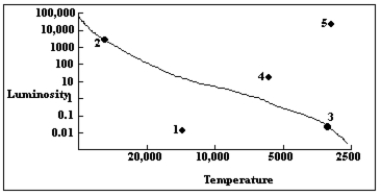
A)1
B)2
C)3
D)4
E)5

A)1
B)2
C)3
D)4
E)5

Unlock Deck
Unlock for access to all 136 flashcards in this deck.
Unlock Deck
k this deck
20
Convection is important in stars because it
A)increases the temperature of the star.
B)mixes the gases of the star.
C)transports energy outward in the star.
D)carries the neutrinos to the surface of the star where they can escape.
E)mixes the gases of the star and transports the energy outward in the star.
A)increases the temperature of the star.
B)mixes the gases of the star.
C)transports energy outward in the star.
D)carries the neutrinos to the surface of the star where they can escape.
E)mixes the gases of the star and transports the energy outward in the star.

Unlock Deck
Unlock for access to all 136 flashcards in this deck.
Unlock Deck
k this deck
21
The lowest-mass object that can initiate thermonuclear fusion of hydrogen has a mass of about
A)1 solar masses.
B)80 solar masses.
C)8 solar masses.
D)0.08 solar masses.
E)0.001 solar masses.
A)1 solar masses.
B)80 solar masses.
C)8 solar masses.
D)0.08 solar masses.
E)0.001 solar masses.

Unlock Deck
Unlock for access to all 136 flashcards in this deck.
Unlock Deck
k this deck
22
Star clusters are important to the study the stellar evolution because stars in a given cluster have the same
A)temperature.
B)mass.
C)age.
D)luminosity.
A)temperature.
B)mass.
C)age.
D)luminosity.

Unlock Deck
Unlock for access to all 136 flashcards in this deck.
Unlock Deck
k this deck
23
The creation of ________ require(s) that a young hot star (T ≈ 25,000 K) be relatively nearby.
A)emission nebulae
B)HI regions
C)molecular clouds
D)the cool gas of the interstellar medium
E)21-cm radiation
A)emission nebulae
B)HI regions
C)molecular clouds
D)the cool gas of the interstellar medium
E)21-cm radiation

Unlock Deck
Unlock for access to all 136 flashcards in this deck.
Unlock Deck
k this deck
24
________ are small dark nebulae about 1 light-year in diameter that contain 10 to 1,000 solar masses.
A)HI regions
B)HII regions
C)Emission nebulae
D)Bok globules
E)Reflection nebulae
A)HI regions
B)HII regions
C)Emission nebulae
D)Bok globules
E)Reflection nebulae

Unlock Deck
Unlock for access to all 136 flashcards in this deck.
Unlock Deck
k this deck
25
Stars are born in
A)reflection nebulae.
B)dense molecular clouds.
C)HII regions.
D)the intercloud medium.
E)the local bubble.
A)reflection nebulae.
B)dense molecular clouds.
C)HII regions.
D)the intercloud medium.
E)the local bubble.

Unlock Deck
Unlock for access to all 136 flashcards in this deck.
Unlock Deck
k this deck
26
If the dust around a protostar radiates most strongly at 30 microns or 30,000 nm, what is the approximate temperature of that dust Hint: T in K = 3,000,000/wavelength in nm or use Wien's Law.
A)100,000 K
B)10,000 K
C)1000 K
D)100 K
E)10 K
A)100,000 K
B)10,000 K
C)1000 K
D)100 K
E)10 K

Unlock Deck
Unlock for access to all 136 flashcards in this deck.
Unlock Deck
k this deck
27
Why do nuclear fusion reactions only take place in the interior of a star
A)The magnetic fields are strongest there.
B)The temperature is the hottest in the center.
C)The density of material is very high in the center.
D)The temperature is the hottest in the center and the density of material is very high in the center.
E)FALSE; Nuclear fusion reactions can take place in the core and corona where temperatures are high enough.
A)The magnetic fields are strongest there.
B)The temperature is the hottest in the center.
C)The density of material is very high in the center.
D)The temperature is the hottest in the center and the density of material is very high in the center.
E)FALSE; Nuclear fusion reactions can take place in the core and corona where temperatures are high enough.

Unlock Deck
Unlock for access to all 136 flashcards in this deck.
Unlock Deck
k this deck
28
Absorption lines due to the interstellar medium indicate that some components of the interstellar medium are cold and of a very low density because
A)the lines are blue shifted.
B)the lines are red shifted.
C)the lines are extremely broad.
D)the lines are extremely narrow.
E)the lines are much darker than the stellar lines.
A)the lines are blue shifted.
B)the lines are red shifted.
C)the lines are extremely broad.
D)the lines are extremely narrow.
E)the lines are much darker than the stellar lines.

Unlock Deck
Unlock for access to all 136 flashcards in this deck.
Unlock Deck
k this deck
29
What is the lifetime on the main sequence of a 2-solar-mass star compared to the approximately 10-billion-year life of our Sun Pick the best answer.
A)1.8 × 1011 years
B)1.8 × 1010 years
C)1.8 × 108 years
D)1.8 × 106 years
E)1.8 × 103 years
A)1.8 × 1011 years
B)1.8 × 1010 years
C)1.8 × 108 years
D)1.8 × 106 years
E)1.8 × 103 years

Unlock Deck
Unlock for access to all 136 flashcards in this deck.
Unlock Deck
k this deck
30
What force(s) are responsible for the collapse of an interstellar cloud
A)nuclear
B)gravity
C)electric
D)magnetic
E)electric and magnetic
A)nuclear
B)gravity
C)electric
D)magnetic
E)electric and magnetic

Unlock Deck
Unlock for access to all 136 flashcards in this deck.
Unlock Deck
k this deck
31
What characteristic of a star primarily determines its location on the main sequence
A)age
B)distance from the galactic center
C)mass
D)space motion
E)radius
A)age
B)distance from the galactic center
C)mass
D)space motion
E)radius

Unlock Deck
Unlock for access to all 136 flashcards in this deck.
Unlock Deck
k this deck
32
As a star begin to form the initial energy source is from
A)nuclear fusion.
B)nuclear fission.
C)gravitational potential energy.
D)magnetic fields.
A)nuclear fusion.
B)nuclear fission.
C)gravitational potential energy.
D)magnetic fields.

Unlock Deck
Unlock for access to all 136 flashcards in this deck.
Unlock Deck
k this deck
33
What causes the outward pressure that balances the inward pull of gravity in a star
A)the outward flow of energy
B)the opacity of the gas
C)the temperature of the gas
D)the density of the gas
E)the temperature and the density of the gas
A)the outward flow of energy
B)the opacity of the gas
C)the temperature of the gas
D)the density of the gas
E)the temperature and the density of the gas

Unlock Deck
Unlock for access to all 136 flashcards in this deck.
Unlock Deck
k this deck
34
The H-R diagram of a young star cluster shows
A)that high-mass stars have not yet reached the main sequence yet.
B)that low-mass stars have not yet reached the main sequence yet.
C)mainly giant stars.
D)no stars since none have reached the main sequence yet.
A)that high-mass stars have not yet reached the main sequence yet.
B)that low-mass stars have not yet reached the main sequence yet.
C)mainly giant stars.
D)no stars since none have reached the main sequence yet.

Unlock Deck
Unlock for access to all 136 flashcards in this deck.
Unlock Deck
k this deck
35
Absorption lines due to interstellar gas
A)are wider than the lines from stars because the gas is hotter than most stars.
B)are narrower than the lines from stars because the gas has a lower pressure than stars.
C)indicate that the interstellar medium contains dust.
D)indicate that the interstellar medium is expanding away from the Sun.
E)None of the other choices are correct.
A)are wider than the lines from stars because the gas is hotter than most stars.
B)are narrower than the lines from stars because the gas has a lower pressure than stars.
C)indicate that the interstellar medium contains dust.
D)indicate that the interstellar medium is expanding away from the Sun.
E)None of the other choices are correct.

Unlock Deck
Unlock for access to all 136 flashcards in this deck.
Unlock Deck
k this deck
36
What must occur for an object to be considered a main-sequence star
A)hydrostatic equilibrium
B)nuclear fusion reaction in the core
C)protostar life begins
D)hydrostatic equilibrium and nuclear fusion reaction in the core
A)hydrostatic equilibrium
B)nuclear fusion reaction in the core
C)protostar life begins
D)hydrostatic equilibrium and nuclear fusion reaction in the core

Unlock Deck
Unlock for access to all 136 flashcards in this deck.
Unlock Deck
k this deck
37
While on the main sequence a star's primary energy source comes from
A)nuclear fusion.
B)nuclear fission.
C)gravitational potential energy.
D)magnetic fields.
A)nuclear fusion.
B)nuclear fission.
C)gravitational potential energy.
D)magnetic fields.

Unlock Deck
Unlock for access to all 136 flashcards in this deck.
Unlock Deck
k this deck
38
A jet has an angular length of 10 seconds of arc and flows from a star at a distance of 2,000 pc. How far does this jet extend away from the star
A)20,000 pc
B)20,000 AU
C)20, 000 ly
D)20,000 miles
E)20,000 km
A)20,000 pc
B)20,000 AU
C)20, 000 ly
D)20,000 miles
E)20,000 km

Unlock Deck
Unlock for access to all 136 flashcards in this deck.
Unlock Deck
k this deck
39
The youngest stars in the Orion Nebula and other star-forming regions also show
A)circumstellar disks.
B)jets.
C)circumstellar disks and jets.
A)circumstellar disks.
B)jets.
C)circumstellar disks and jets.

Unlock Deck
Unlock for access to all 136 flashcards in this deck.
Unlock Deck
k this deck
40
What is the lifetime of a 10-solar-mass star on the main sequence
A)3.2 × 107 years
B)320 years
C)3.2 × 1012 years
D)1× 109 years
E)1 × 1011 years
A)3.2 × 107 years
B)320 years
C)3.2 × 1012 years
D)1× 109 years
E)1 × 1011 years

Unlock Deck
Unlock for access to all 136 flashcards in this deck.
Unlock Deck
k this deck
41
The above visual wavelength image is of a ___________, which is a(n) _________. 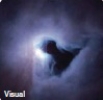
A)dark nebula, empty space
B)reflection nebula, dark cloud
C)Bok globule, empty space
D)emission nebula, dark cloud

A)dark nebula, empty space
B)reflection nebula, dark cloud
C)Bok globule, empty space
D)emission nebula, dark cloud

Unlock Deck
Unlock for access to all 136 flashcards in this deck.
Unlock Deck
k this deck
42
The central cores of which type of star is the lowest temperature
A)protostars.
B)massive main-sequence stars.
C)white dwarf stars.
A)protostars.
B)massive main-sequence stars.
C)white dwarf stars.

Unlock Deck
Unlock for access to all 136 flashcards in this deck.
Unlock Deck
k this deck
43
A ZAMS star evolves __________ and to the __________ on the H-R diagram because ________________.
A)downward, left, the core expands which causes the outer layers to expand
B)upward, right, the core contracts which causes the outer layers to expand
C)upward, left, the core expands which causes the outer layers to contract
D)downward, right, the core contracts which causes the outer layers to contract
A)downward, left, the core expands which causes the outer layers to expand
B)upward, right, the core contracts which causes the outer layers to expand
C)upward, left, the core expands which causes the outer layers to contract
D)downward, right, the core contracts which causes the outer layers to contract

Unlock Deck
Unlock for access to all 136 flashcards in this deck.
Unlock Deck
k this deck
44
The above image is an example of a/an ____________. 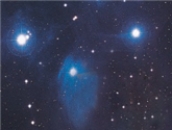
A)cluster of stars producing reflection nebula
B)T association
C)OB association
D)Trapezium cluster

A)cluster of stars producing reflection nebula
B)T association
C)OB association
D)Trapezium cluster

Unlock Deck
Unlock for access to all 136 flashcards in this deck.
Unlock Deck
k this deck
45
A ZAMS star is located _______________________.
A)above the main sequence
B)on the upper edge of the main sequence
C)in the middle of the main sequence
D)on the lower edge of the main sequence
A)above the main sequence
B)on the upper edge of the main sequence
C)in the middle of the main sequence
D)on the lower edge of the main sequence

Unlock Deck
Unlock for access to all 136 flashcards in this deck.
Unlock Deck
k this deck
46
in the following image, the blue color is from a/an ____________ nebula whereas the pink color is from a/an ___________ nebula. 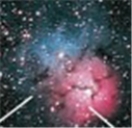
A)dark, reflection
B)reflection, emission
C)emission, dark
D)emission, reflection

A)dark, reflection
B)reflection, emission
C)emission, dark
D)emission, reflection

Unlock Deck
Unlock for access to all 136 flashcards in this deck.
Unlock Deck
k this deck
47
In the following visible + near infrared image, the white color is the ______, the red color is the __________, and the lack of white color (or black color) sandwiched between the upper white half-moon shape and the lower white half-moon shape is _________________. 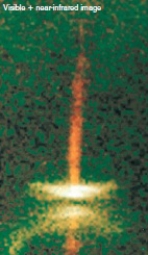
A)star, jet, the infrared part
B)disk, Herbig-Haro object, empty space
C)surface disk, jet, the dense dust disk
D)None of the other choices are correct.

A)star, jet, the infrared part
B)disk, Herbig-Haro object, empty space
C)surface disk, jet, the dense dust disk
D)None of the other choices are correct.

Unlock Deck
Unlock for access to all 136 flashcards in this deck.
Unlock Deck
k this deck
48
What evidence indicates protostars have formed
A)jets
B)bipolar outflows
C)protostellar disks
D)All of the other choices are correct.
A)jets
B)bipolar outflows
C)protostellar disks
D)All of the other choices are correct.

Unlock Deck
Unlock for access to all 136 flashcards in this deck.
Unlock Deck
k this deck
49
The image on the right indicates star formation that we cannot see in the wavelength band on the left. The image on the left is a/an __________ wavelength image of the ___________ wavelength image on the right. 
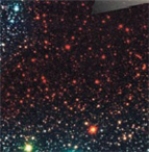
A)radio, infrared
B)infrared, visual
C)visual, infrared
D)infrared, radio


A)radio, infrared
B)infrared, visual
C)visual, infrared
D)infrared, radio

Unlock Deck
Unlock for access to all 136 flashcards in this deck.
Unlock Deck
k this deck
50
The hottest star in the Orion Nebula ____________hydrogen gas and makes it _____________.
A)ionizes; glow
B)neutralizse; glow
C)ionizes; swallow the star
A)ionizes; glow
B)neutralizse; glow
C)ionizes; swallow the star

Unlock Deck
Unlock for access to all 136 flashcards in this deck.
Unlock Deck
k this deck
51
The above image is an example of a ________. 
A)protostellar disk
B)YSO
C)protostar
D)Herbig-Haro object

A)protostellar disk
B)YSO
C)protostar
D)Herbig-Haro object

Unlock Deck
Unlock for access to all 136 flashcards in this deck.
Unlock Deck
k this deck
52
If in a gas the opacity is high, then energy transport is by _____________.
A)conduction
B)convection
C)radiation
D)All of the other choices are correct.
A)conduction
B)convection
C)radiation
D)All of the other choices are correct.

Unlock Deck
Unlock for access to all 136 flashcards in this deck.
Unlock Deck
k this deck
53
Which of the following energy transport processes involves mass motions of material
A)radiation
B)conduction
C)convection
D)All of the other choices are correct.
A)radiation
B)conduction
C)convection
D)All of the other choices are correct.

Unlock Deck
Unlock for access to all 136 flashcards in this deck.
Unlock Deck
k this deck
54
In the Herbig-Haro object shown above, the Herbig-Haro is the ___________. 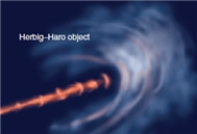
A)red jet
B)white/blue colored interstellar medium the red jet runs into
C)dusty disk containing a newborn star and the red jet
D)All of these choices are correct.

A)red jet
B)white/blue colored interstellar medium the red jet runs into
C)dusty disk containing a newborn star and the red jet
D)All of these choices are correct.

Unlock Deck
Unlock for access to all 136 flashcards in this deck.
Unlock Deck
k this deck
55
Which of the following is a method of energy transport
A)convection
B)radiation
C)conduction
D)All of the other choices are correct.
A)convection
B)radiation
C)conduction
D)All of the other choices are correct.

Unlock Deck
Unlock for access to all 136 flashcards in this deck.
Unlock Deck
k this deck
56
The above reactions are of the ___________________. 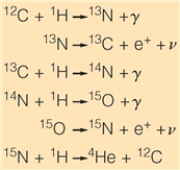
A)proton-proton fusion chain
B)hydrogen-hydrogen fusion chain
C)CNO cycle
D)All of the other choices are correct.

A)proton-proton fusion chain
B)hydrogen-hydrogen fusion chain
C)CNO cycle
D)All of the other choices are correct.

Unlock Deck
Unlock for access to all 136 flashcards in this deck.
Unlock Deck
k this deck
57
Which is the correct evolutionary order
A)protostar, ZAMS, YSO
B)protostar, YSO, ZAMS
C)ZAMS, protostar, YSO
D)ZAMS, YSO, protostar
A)protostar, ZAMS, YSO
B)protostar, YSO, ZAMS
C)ZAMS, protostar, YSO
D)ZAMS, YSO, protostar

Unlock Deck
Unlock for access to all 136 flashcards in this deck.
Unlock Deck
k this deck
58
You would like to see through the dust in a cloud to find protostars. Which band of the electromagnetic spectrum would you need to look in
A)infrared
B)visual
C)UV
D)X-ray
A)infrared
B)visual
C)UV
D)X-ray

Unlock Deck
Unlock for access to all 136 flashcards in this deck.
Unlock Deck
k this deck
59
What is the correct fraction of dust to gas in the interstellar medium
A)1/99
B)10/90
C)50/50
D)90/10
A)1/99
B)10/90
C)50/50
D)90/10

Unlock Deck
Unlock for access to all 136 flashcards in this deck.
Unlock Deck
k this deck
60
in the following cartoon image of Orion, where would you find the Orion nebula 
A)below the belt (i.e., three white stars) but above the lower right blue and lower left white stars
B)above the belt (i.e., three white stars) but below the upper red and the upper white stars
C)in the belt, that is, among the three white stars
D)outside the white lines

A)below the belt (i.e., three white stars) but above the lower right blue and lower left white stars
B)above the belt (i.e., three white stars) but below the upper red and the upper white stars
C)in the belt, that is, among the three white stars
D)outside the white lines

Unlock Deck
Unlock for access to all 136 flashcards in this deck.
Unlock Deck
k this deck
61
You would use the 21-cm radio emission line to map out ____________.
A)the interstellar medium
B)molecular clouds
C)atomic hydrogen clouds
D)All of the other choices are correct.
A)the interstellar medium
B)molecular clouds
C)atomic hydrogen clouds
D)All of the other choices are correct.

Unlock Deck
Unlock for access to all 136 flashcards in this deck.
Unlock Deck
k this deck
62
The above visual wavelength image of the Trapezium cluster shows _________. 
A)main sequence and protostars
B)protostars and YSOs
C)YSOs and ZAMS
D)ZAMS and protostars

A)main sequence and protostars
B)protostars and YSOs
C)YSOs and ZAMS
D)ZAMS and protostars

Unlock Deck
Unlock for access to all 136 flashcards in this deck.
Unlock Deck
k this deck
63
The condition of ____________________ means that the force due to gravity pushing down on a layer is exactly equal to the pressure pushing outward on that layer.

Unlock Deck
Unlock for access to all 136 flashcards in this deck.
Unlock Deck
k this deck
64
The interstellar medium is made of ___ % dust and ___ % gas.
A)1, 99
B)0, 100
C)100, 0
D)5, 95
A)1, 99
B)0, 100
C)100, 0
D)5, 95

Unlock Deck
Unlock for access to all 136 flashcards in this deck.
Unlock Deck
k this deck
65
Which of the following in not a factor that prevents molecular cloud contraction
A)thermal motion
B)a force exerted by a magnetic field
C)orbital motion
D)turbulence
A)thermal motion
B)a force exerted by a magnetic field
C)orbital motion
D)turbulence

Unlock Deck
Unlock for access to all 136 flashcards in this deck.
Unlock Deck
k this deck
66
Star may appear fainter due to the interstellar medium. This effect is known as ____________________.
A)interstellar reddening
B)interstellar extinction
C)interstellar absorption line
D)interstellar dust
A)interstellar reddening
B)interstellar extinction
C)interstellar absorption line
D)interstellar dust

Unlock Deck
Unlock for access to all 136 flashcards in this deck.
Unlock Deck
k this deck
67
The above image is an example of a/an _________ nebula. 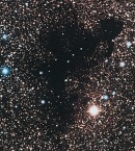
A)dark
B)emission
C)Bok globule
D)reflection

A)dark
B)emission
C)Bok globule
D)reflection

Unlock Deck
Unlock for access to all 136 flashcards in this deck.
Unlock Deck
k this deck
68
The densest, coldest clouds are called _____________.
A)reflection nebula
B)dark nebula
C)Bok globules
D)molecular clouds
A)reflection nebula
B)dark nebula
C)Bok globules
D)molecular clouds

Unlock Deck
Unlock for access to all 136 flashcards in this deck.
Unlock Deck
k this deck
69
____________________ is the resistance of a gas to the flow of radiation.

Unlock Deck
Unlock for access to all 136 flashcards in this deck.
Unlock Deck
k this deck
70
____________________ appear reddish in color due to the light emitted by the Balmer series of the hydrogen atom.

Unlock Deck
Unlock for access to all 136 flashcards in this deck.
Unlock Deck
k this deck
71
Stars are born in ______________________.
A)molecular clouds
B)atomic hydrogen clouds
C)emission nebula
D)reflection nebula
A)molecular clouds
B)atomic hydrogen clouds
C)emission nebula
D)reflection nebula

Unlock Deck
Unlock for access to all 136 flashcards in this deck.
Unlock Deck
k this deck
72
Energy transport by ____________________ is important when photons cannot readily travel through a gas.

Unlock Deck
Unlock for access to all 136 flashcards in this deck.
Unlock Deck
k this deck
73
How long can a 1-solar-mass star live
A)0.5 solar lifetimes
B)1 solar lifetime
C)2 solar lifetimes
D)10 solar lifetimes
A)0.5 solar lifetimes
B)1 solar lifetime
C)2 solar lifetimes
D)10 solar lifetimes

Unlock Deck
Unlock for access to all 136 flashcards in this deck.
Unlock Deck
k this deck
74
The above image is a/an _________ wavelength image of a reflection nebula. 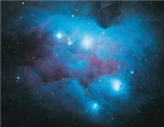
A)infrared
B)visual
C)radio
D)X-ray

A)infrared
B)visual
C)radio
D)X-ray

Unlock Deck
Unlock for access to all 136 flashcards in this deck.
Unlock Deck
k this deck
75
The pressure of an interstellar gas cloud depends on the cloud's ____________________ and ____________________.

Unlock Deck
Unlock for access to all 136 flashcards in this deck.
Unlock Deck
k this deck
76
The interstellar medium is made of ______________.
A)gas
B)dust
C)gas and dust
D)None of these choices are correct.
A)gas
B)dust
C)gas and dust
D)None of these choices are correct.

Unlock Deck
Unlock for access to all 136 flashcards in this deck.
Unlock Deck
k this deck
77
A spectral line produced in the atmosphere of a star may be seen as broad whereas interstellar _______________ lines are very narrow.
A)absorption
B)continuous
C)emission
D)All of the other choices are correct.
A)absorption
B)continuous
C)emission
D)All of the other choices are correct.

Unlock Deck
Unlock for access to all 136 flashcards in this deck.
Unlock Deck
k this deck
78
To initiate star formation in a cloud, you need a __________.
A)slow contraction of a molecular cloud
B)rotating molecular cloud
C)magnetic field
D)shock
A)slow contraction of a molecular cloud
B)rotating molecular cloud
C)magnetic field
D)shock

Unlock Deck
Unlock for access to all 136 flashcards in this deck.
Unlock Deck
k this deck
79
How long can a four-solar-mass star live
A)1 solar lifetime
B)0.03125 solar lifetimes
C)3 solar lifetimes
D)None of the other choices are correct.
A)1 solar lifetime
B)0.03125 solar lifetimes
C)3 solar lifetimes
D)None of the other choices are correct.

Unlock Deck
Unlock for access to all 136 flashcards in this deck.
Unlock Deck
k this deck
80
A star has crossed the birth line and thus that star is now called a ________________.
A)main-sequence star
B)protostar
C)YSO
D)ZAMS
A)main-sequence star
B)protostar
C)YSO
D)ZAMS

Unlock Deck
Unlock for access to all 136 flashcards in this deck.
Unlock Deck
k this deck



